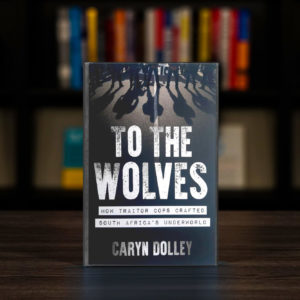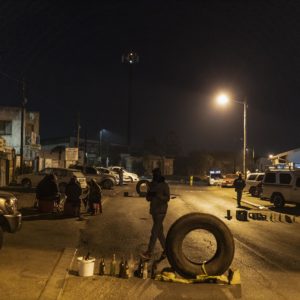Book Review | Why the police are not indispensable
Two new books explore police violence and its roots in slavery and the colonies, contending that the police serve power, not the people. Both argue for community-led alternatives to public safety.
Author:
21 October 2021

The police represent a contradiction of modern life. Politicians, the media and cops themselves claim they are the “thin blue line” that protects us from crime and a descent into chaos and barbarism. But throughout the world, police forces are regularly implicated in corruption and human rights abuses. In South Africa, a recent survey by Afrobarometer showed that most citizens believe the police are untrustworthy and incapable of preventing crime.
Rather than keeping society safe, police focus on enforcing social hierarchies and inequality, evicting the impoverished from their homes, harassing street traders, extorting bribes and shooting at protesters with potentially lethal rubber bullets. As two new books argue, this abuse is not just a global phenomenon, it is also intrinsic to the nature of the police as an institution. Violent Order: Essays on the Nature of the Police (Haymarket Books, 2021), edited by David Correia and Tyler Wall and A World Without Police: How Strong Communities Make Police Obsolete (Verso, 2021) by Geo Maher look at the grim reality of police and state power.
Released a year after the protests against the police murder of George Floyd rocked the United States, both books reflect the growing movement for police abolition, which calls for emancipatory alternatives to public safety. Abolitionists believe that authoritarian state violence makes society both undemocratic and unsafe. They call for alternative methods of addressing problems of crime and violence.
Related article:
Violent Order is the successor to Correia and Wall’s previous collaboration Police: A Field Guide (Verso, 2018). That book deconstructed what they call “cop-speak”, showing how euphemisms such as “security” and “order” are in practise used to legitimise abusive and sinister tactics of domination.
The essays collected in this book expand their analysis, with the contributors touching on themes from police dogs to the ways that police are implicated in the corporate destruction of the environment.
In their introductory piece, Correia and Wall argue that the history of modern policing shows that security institutions are not primarily concerned with fighting crime, but rather with the more nebulous target of enforcing “order”. From slave patrols in the 18th century to the hyper-militarised forces of today, this is an order based on class, racial and gender injustice. They argue that police use everyday violence to “fabricate bourgeois order” – or an order where people are turned into compliant subject-consumers and where nature is turned into a commodity for exploitation.
The book’s chapters use both historical and contemporary examples to show that policing is not a politically neutral social service. Instead it is an institution with a primary focus on controlling the impoverished and working class, and clamping down on political dissent.
Structures of power
Rather than focusing on pragmatic crime prevention, policing is based on a Manichean morality, where the world is divided into good police and an evil, unruly citizenry who need to be kept on a tight leash. As Phillip V McHarris argues in his chapter, this actually makes us less secure: “The focus on good versus evil, the latter of which is attributed to an inherent culture or ontological disposition, creates limitations to ending violence within communities, including patriarchal violence. Abolitionists present visions of safe, accountable communities that do not exacerbate existing harms along the way.”
The theme of abolition is the focus of Geo Maher’s A World Without Police. Writing from the dual perspectives of scholar and activist, Maher explores how abolition is not a call for a nihilistic world without laws, but is rather based on a vision of justice that cannot be achieved under the existing criminal justice system.
The book begins with a historical survey of policing and the ways that it was used to enforce the authoritarian institutions of slavery and colonialism. Never decisively breaking with this sordid past, modern cops continue this tradition in new guises.
Related article:
For Maher, the police force is not designed to serve the general public. Instead, its primary role is to uphold dominant political and economic power structures – often to the detriment of providing actual safety. For example, police are often called in to deal with social conflicts that arise from poverty and mental illness. But instead of de-escalating these situations, the violent force often used by police actively makes them worse.
He argues, “If someone robs your house or assaults you, the truth is that the vast policing apparatus has done nothing to prevent that from happening. But by a bizarre sleight of hand, police continue to cite their own abysmal failures as proof of their own indispensability.”
In contrast, he outlines a long history of community self-defence, where people democratically organised to ensure safety without the state. During the 1919 Seattle General Strike, workers created community militias “to preserve law and order without the use of force”.
During the civil rights struggles of the 1960s, activists faced terror from groups like the Ku Klux Klan, which racist police forces tacitly condoned. This inspired the creation of armed self-defence groups and “rifle clubs”.
Non-authoritarian alternatives
Maher particularly focuses on Latin America. As in South Africa today, states committed to neoliberal austerity have abandoned many impoverished communities, leaving people to self-organise to survive in desperate circumstances.
This inspired a remarkable wave of democratically organised public safety mechanisms. In Mexico City, where residents are plagued by both police corruption and criminal violence, activists took over unused land to create La Polvorilla, a safezone full of community gardens, where checkpoints are staffed by women. This has created an “oasis amid a desert of poverty and grey houses”, which provides a space of dignity and peace for the impoverished.
While exploring a range of alternatives for community safety, Maher also discusses the dangers of vigilantism and mob justice. These are very real risks, but he makes the compelling case that direct democracy and community oversight can help prevent the rise of toxic popular violence. Even in the midst of terrible poverty and appealing violence, communities have created non-authoritarian models of safety, which deal with both social violence and its root causes.
Related article:
Both these books combine political theory and history with accessible writing. Read together, they make the argument that police are an archaic, anti-democratic and, as Maher puts it, “useless” institution that exists to preserve the wealth and power of the rich.
In a world of state, economic and environmental collapse, the police offer the majority of us no safety at all. In fact, they are central to sustaining the late-capitalist disorder. At the same time, the Left needs to address people’s legitimate fears of being victims of crime. These works demonstrate that democratic and egalitarian alternatives already exist.



